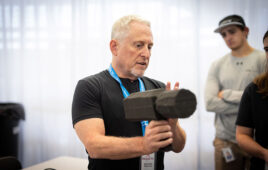NASA’s unmanned New Horizons spacecraft was launched in 2006. After a journey of about three billion miles, it will achieve its closest approach to Pluto on July 14. The mission is providing us with our first-ever close-up look at the dwarf planet and its moons.
 New Horizons was developed in NASA’s Payload Hazardous Servicing Facility at the Kennedy Space Center. The Payload Hazardous Servicing Facility can double as a payload processing facility and a hazardous processing facility. It is environmentally controlled by a Class 5,000 air at filter discharge. The temperature remains at 70 F, plus or minus 5 F. An emergency exhaust system is provided for diluting and removing hazardous fuel and oxidizer vapors.
New Horizons was developed in NASA’s Payload Hazardous Servicing Facility at the Kennedy Space Center. The Payload Hazardous Servicing Facility can double as a payload processing facility and a hazardous processing facility. It is environmentally controlled by a Class 5,000 air at filter discharge. The temperature remains at 70 F, plus or minus 5 F. An emergency exhaust system is provided for diluting and removing hazardous fuel and oxidizer vapors.
A suite of seven science instruments on board the craft will collect data to send back to Earth —advanced imaging infrared and ultraviolet spectrometers, a compact multicolor camera, a high-resolution telescopic camera, two powerful particle spectrometers, a space-dust detector designed and built by students at the University of Colorado and two radio science experiments. The entire spacecraft draws its electricity from a single radioisotope thermoelectric generator, and operates on less power than a pair of 100-watt light bulbs. The data the instruments collect could unveil possible changes in ice on Pluto’s surface.
New Horizons received a boost in speed when it passed Jupiter in 2007. In a “gravity assist maneuver,” the craft went down into Jupiter’s gravity well and came out, slingshot-style, with enough extra velocity to get it to Pluto five years sooner. It speed clocked in at over 52,000 miles per hour, which is fast enough to get to New York from Tokyo in under eight minutes.
The spacecraft came out of its electronic slumber in December 2014, in preparation for the historic flyby. The hibernation period lasted about two-thirds of its total flight time — 1,873 days, spread over 18 separate hibernation periods from mid-2007 to late 2014 that ranged from 36 days to 202 days long.
Use hashtag #PlutoFlyby on Twitter to find more information about this exciting mission.




